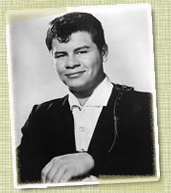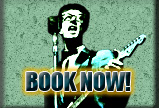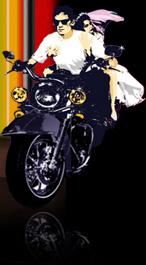


Charles Hardin Holley
(September 7, 1936 – February 3, 1959), better known as Buddy Holly, was an American singer, songwriter, and a pioneer of Rock and Roll. The change of spelling of Holley to Holly came about because of an error in a contract he was asked to sign, listing him as Buddy Holly. That spelling was then adopted for his professional career.
Holley was born in Lubbock, Texas. The Holleys were a musical family and as a young boy Holley learned to play the violin, piano and guitar. In the fall of 1949 he met Bob Montgomery at Hutchison Jr. High School. They shared a common interest in music, and soon teamed up to perform as the duo ‘Buddy and Bob’. Initially influenced by bluegrass music, they sang harmony duets at local clubs and high school talent shows. Holley's big break came when they opened for Bill Haley and his Comets at a local rock show organized by Eddie Crandall who was also the manager for Marty Robbins. As a result of this performance, Holley was offered a contract with Decca Records to work alone. However, early success as a solo artist eluded him.
Back in Lubbock, Holley formed his own band, ‘The Crickets’, and began making records at Norman Petty's studios in Clovis, New Mexico. Among the songs they recorded was "That'll Be The Day", which takes its title from a phrase that John Wayne's character uses repeatedly in the movie, The Searchers. Petty had music industry contacts, and believing that "That'll Be The Day" would be a hit single, he contacted publishers and labels. Coral Records, a subsidiary of Decca, signed Buddy Holly and The Crickets. This put Buddy in the unusual position of having two record contracts at the same time. Before "That'll Be The Day" had its nationwide release and became a smash hit, Holley played lead guitar on the hit-single "Starlight", recorded in April 1957, featuring Jack Huddle.
Holly's music was sophisticated for its day, including the use of instruments considered novel for rock and roll, such as the celesta (heard on "Everyday"). Holly was an influential lead and rhythm guitarist, notably on songs such as "Peggy Sue" and "Not Fade Away". While Holly could pump out ‘boy-loves-girl’ songs with the best of his contemporaries, other songs featured more sophisticated lyrics and more complex harmonies and melodies than had been previously shown in the genre. Many of his songs feature a unique vocal ‘hiccup’ technique, a clipped ‘uh’ sound used to emphasize certain words in any given song, especially the rockers. For example, the start of the raucous number "Rave On": "We-UH-ell, the little things you say and do, make me want to be with you-UH-ou..."
Holly also managed to bridge some of the racial divide that punctuated rock, notably winning over an all-black audience when accidentally booked for New York's Apollo Theatre.
After the release of several highly successful songs, in March of 1958, he and the Crickets toured the United Kingdom. In the audience were teenagers named John Lennon and Paul McCartney, who later cited Holly as a primary influence (the band's name, The Beatles, was later chosen partly in homage to Holly's Crickets). The Beatles did a cover version of "Words Of Love" that was an almost perfect reproduction of Holly's version. The Rolling Stones did a cover of "Not Fade Away." The group, The Hollies were named in homage.
Holly's personal style, more controlled and cerebral than Elvis's and more youthful and innovative than the country and western stars of his day, would have an influence on youth culture on both sides of the Atlantic for decades to come, reflected particularly in the New Wave movement in artists such as Elvis Costello and Marshall Crenshaw, and earlier in folk rock bands like The Byrds and The Turtles.
He married Maria Elena Santiago on August 15, 1958.
In 1959, Holly split with the Crickets and began a solo tour with other notable performers including Ritchie Valens and J.P. Richardson, ‘The Big Bopper’. One audience member at the tour stop in Duluth, Minnesota, was a young Bobby Zimmerman who would later be known as Bob Dylan.
Following the February 2nd performance at the Surf Ballroom in Clear Lake, Iowa, the performers and their road crew drew straws to decide who would fly in the airplane, and who would ride in the unheated tour bus. The winners were Holly, Valens and Richardson. The four-passenger Beechcraft Bonanza took off into a blinding snow storm and crashed into Albert Juhl's corn field several miles after takeoff at 1.05am. The crash killed Holly, Valens, Richardson, and pilot Roger Peterson, leaving Holly's pregnant bride, Maria Elena Holly, a widow (she would miscarry soon after). Funeral services were held at the Tabernacle Baptist Church in Lubbock, Texas, and Buddy Holly was interred in the City of Lubbock Cemetery.
Holly's headstone carries the correct spelling of his name, Buddy Holley. It also features a carving of his favourite guitar. Downtown Lubbock has a ‘walk of fame’ with plaques to various area artists such as Mac Davis and Waylon Jennings, with a life-size statue of a guitar playing Buddy as its centrepiece. The tragic plane crash inspired singer Don McLean's popular 1971 ballad "American Pie", and immortalized February 3rd as "The Day The Music Died". Contrary to popular myth, "American Pie" was not the name of the ill-fated airplane.
The Surf Ballroom, a popular and old-fashioned dance hall that dates to the height of Big Band Era, continues to put on shows, notably an annual Buddy Holly tribute on the anniversary of his last performances.

Jiles Perry Richardson, Jr.
(October 24, 1930 – February 3, 1959), better known as The Big Bopper (but called 'Jape' by friends) was a disc jockey who parlayed a big voice and exuberant personality into a career as an early rock and roll star. He is best known for his hit song "Chantilly Lace".
He was born in Sabine Pass, Texas, the oldest son of Jiles Perry, Sr. and Elise (Stalsby) Richardson. His father was an oil field worker and driller. He had two younger brothers, Cecil and James. Within a short time the family moved to Beaumont, Texas. He graduated from Beaumont High School in 1947 and was a member of the "Royal Purple" football team, wearing number ‘85’ as a defensive lineman.
Richardson later studied law at Lamar College, and was a member of the band and chorus. During this time he worked part time at KTRM Radio. On April 18, 1952, Richardson married Adrianne Joy Fryou from Montegut, Louisiana, and by 1955 he had joined the United States Army, where he spent two years as a radar instructor at Fort Bliss. Upon his discharge, he began working at KTRM Radio, where he held down the "Dishwashers' Serenade" shift from 11am to 12.30pm, Monday through Friday.
One of the sponsors wanted Richardson for a new time slot and suggested a gimmick for the show. Richardson noticed all the college kids doing a dance called The Bop, so he decided to become known as ‘The Big Bopper’. He kicked off a new radio show from 3-6pm and soon The Big Bopper became the station's program director. In May of 1957, Jape Richardson broke the record for continuous on-the-air broadcasting by eight minutes. He went a total of five days, two hours and eight minutes, playing 1,821 records and taking showers during five-minute newscasts. During the marathon, he lost 35 pounds (16 kg). KTRM paid Richardson $746.50 for his overtime and he quickly hit the sack for 20 hours.
Around this time, Richardson – who played guitar – started writing more songs. George Jones later recorded Richardson's "White Lightning", which became his first #1 country hit in 1959 (#73 on the pop charts). Richardson also wrote "Running Bear" for his friend from Port Arthur, Texas, Johnny Preston. Inspiration for the song came from Richardson's childhood memory of the Sabine River, where he heard stories about Indian tribes. Jape sang background on "Running Bear" but it wasn't released until September 1959, after his death. Within several months it went to #1.
The man who launched Richardson as a recording artist was Harold ‘Pappy’ Dailey from Houston. Dailey was promotion director for Mercury and Starday Records and signed Richardson to Mercury. Richardson's first single "Beggar To A King" had a country flavor, but failed to gain any chart action. He soon cut "Chantilly Lace" as ‘The Big Bopper’ for Pappy Dailey's D label. Mercury bought the recording and released it during the summer of 1958. It reached 16 on the pop charts and spent 22 weeks on the national Top 40.
With the success of "Chantilly Lace", Richardson took some time off from KTRM Radio and joined Buddy Holly and the Crickets, Ritchie Valens, and Dion & the Belmonts for a ‘Winter Dance Party’ tour. On February 2, 1959, Buddy Holly chartered a Beechcraft Bonanza to take him and his new Crickets band (Tommy Allsup and Waylon Jennings) to Fargo, North Dakota. Richardson came down with the flu and didn't feel comfortable on the bus, so Waylon gave his plane seat to him. Valens had never flown on a small plane and requested Allsup's seat. They flipped a coin and Valens called heads and won the toss.
In the early morning of February 3, following a February 2 performance at the Surf Ballroom in Clear Lake, Iowa, the small four-passenger Beechcraft Bonanza took off into a blinding snow storm and crashed into Albert Juhl’s corn field several miles after takeoff at 1.05am. The crash killed Holly, Valens, Richardson and pilot Roger Peterson. This event would become known as "The Day the Music Died".
At the time of his death, Richardson, 28, left behind his wife Adrianne Joy, four-year-old Debra Joy, and a baby son who was born after his death, Jay P. Richardson. Richardson had been building a recording studio in his home in Beaumont, Texas, before that last tour and was also planning to invest in the ownership of a radio station. In addition, he had written 20 new songs with plans to record by himself and with other artists. Richardson was a well-loved figure who was known to care deeply about his family.
In 1988, Ken Paquette, a Wisconsin fan of the ’50s era, erected a stainless steel monument depicting a steel guitar and a set of three records bearing the names of each of the three performers. It is located on private farmland, about one quarter mile west of the intersection of 315th Street and Gull Avenue, approximately eight miles north of Clear Lake. He also created a similar stainless steel monument to the three musicians near the Riverside Ballroom in Green Bay, Wisconsin. That memorial was unveiled on July 17, 2003.
The Big Bopper is fondly remembered not only for his distinctive singing and songwriting, but also as a humorist who combined the best elements of country, R&B and rock 'n' roll.

Richard Steven Valenzuela
(May 13, 1941 – February 3, 1959), better known as Ritchie Valens, was a pioneer of rock and roll and, as a Mexican-American born in Los Angeles, California, became the first Hispanic rock and roll star.
Valens' hits included "Come On, Let's Go", "Donna", and "La Bamba"; the latter became the title of a 1987 movie about his life (see La Bamba), which introduced Lou Diamond Phillips as Ritchie and co-starred Esai Morales as his older half-brother Bob Morales.
Valens was a pioneer of Hispanic rock and influenced the likes of Chris Montez and Carlos Santana.
In early 1959, Valens was travelling the Midwest on a multi-act rock and roll tour. In the early morning following a February 2nd performance at the Surf Ballroom in Clear Lake, Iowa, a small four-passenger Beechcraft Bonanza aircraft departed into a blinding snowstorm and crashed into Albert Juhl's cornfield several miles after takeoff at 1.05am. The crash killed Valens, along with co-performers Buddy Holly, J.P. 'The Big Bopper' Richardson, and the pilot Roger Peterson. This event inspired singer Don McLean's popular 1971 ballad "American Pie", and immortalized February 3rd as "The Day The Music Died".
Ritchie Valens is interred in the San Fernando Mission Cemetery in Mission Hills, California. He has a star on the Hollywood Walk of Fame at 6733 Hollywood Blvd. in Hollywood, California, and he was inducted into the Rock and Roll Hall of Fame in 2001.














